
Winter can be harsh on roofs, with freezing temperatures, heavy snow, and ice taking their toll. If not addressed promptly, these issues can lead to costly repairs or structural damage. Identifying common winter problems and knowing how to deal with them can protect your home and save you money. In this article, we’ll explore three of the most common winter roofing problems and practical solutions to keep your roof in good shape.
1. Ice dams
When the heat from your attic melts snow on your roof, it causes water to flow toward the edges, where it freezes, forming an ice dam. This buildup creates a barrier that prevents water from draining correctly, forcing it under the shingles and into your home. If not addressed quickly, ice dams often result in water damage, mold growth, and structural issues.
Invest in proper attic insulation and ventilation to maintain consistent roof temperature and prevent ice dams. If they are already formed, here’s how to remove ice dams from your roof:
- Use a roof rake to remove snow from your roof. Focus on clearing the areas just above the ice dam to prevent additional buildup. Remember to be careful not to damage the shingles using the roof rake.
- Melt the ice with calcium chloride: Fill a pantyhose or sock with calcium chloride and place it across the ice dam. The calcium chloride melts the ice slowly, allowing water to flow off the roof. Be sure to position the calcium chloride carefully to avoid direct contact with the shingles. You should also not use rock salt in place of calcium chloride. Rock salt damages shingles.
- Hire a professional: If the ice dam is extensive or you’re not sure about handling it safely, call a roofing expert or ice removal service. They have the tools and experience to safely remove ice dams without damaging your roof.
2. Snow load
One of the most significant winter roofing problems, especially if you live in an area with heavy snowfall, is snow load. When snow accumulates, it adds significant weight to your roof. If this load becomes too heavy, it can cause the structure to sag. In severe cases, snow load can result in roof collapse. To address snow load, you can take the following steps:
- Monitor snow levels: Be aware of how much snow is on your roof, especially after a heavy storm. Wet, dense snow is significantly heavier than fresh, fluffy snow.
- Remove snow safely: Use a roof rake to clear excess snow, starting from the edges and working your way up. Avoid climbing onto the roof to prevent accidents.
- Inspect for warning signs: Watch for cracks in walls, doors that stick, or sagging in the roof, as these may indicate excessive weight.
3. Roof leaks
Leaks are a common roofing issue in winter due to freeze-thaw cycles. Fluctuating temperatures cause water to freeze and expand in small cracks or gaps in your roof. Over time, this expansion widens the cracks, allowing water to enter your home. This damages your house’s insulation, ceilings, and walls.
Before winter, inspect your roof for damaged shingles or cracks and repair them. You could apply roof sealant to seal small gaps. If you identify a leak during winter, hire a roofing contractor for repairs to prevent extensive water damage and mold growth.
Endnote
Winter can be challenging for your roof, but staying proactive can help you avoid costly repairs and keep your home safe. Be sure to promptly address issues like ice dams, snow load, and roof leaks to reduce the risks caused by freezing temperatures and heavy snow.












